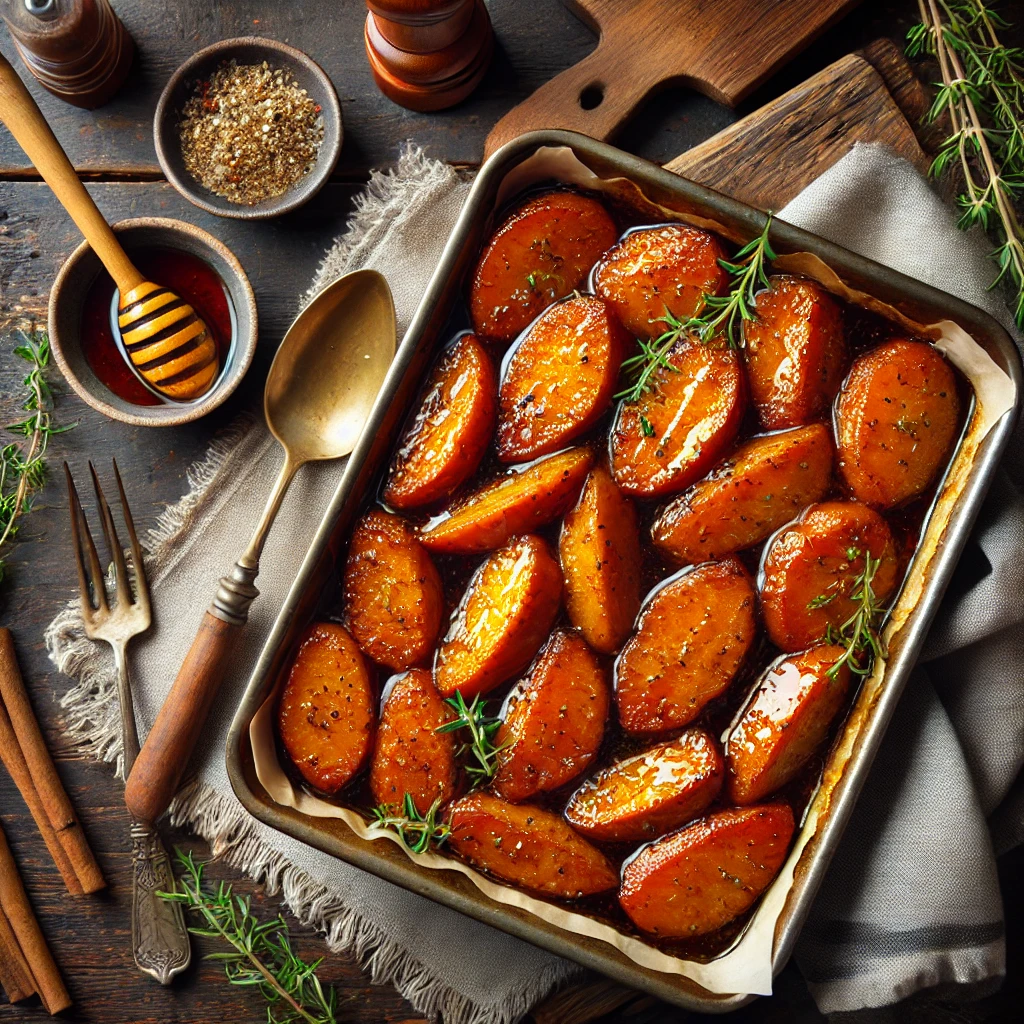Candied yams are a holiday classic, but sometimes they can turn out runny instead of having that perfect, thick syrupy glaze. The balance between moisture and caramelization is crucial for making delicious candied yams. In this guide, we’ll explore why candied yams can become watery and share practical tips to ensure your dish turns out perfectly.

What Are Candied Yams?
Candied yams are made by cooking yams (or sweet potatoes) in a mixture of butter, sugar, and spices until they’re tender and coated in a thick, caramelized glaze. This dish is especially popular during Thanksgiving and other festive gatherings.
If you’re interested in more festive dessert ideas, check out this Pumpkin Banana Loaf recipe for another delightful addition to your holiday table.
Why Do Candied Yams Become Runny?
Several factors can cause candied yams to turn out watery:
- Excess moisture from the yams: Yams release water when cooked, which can dilute the glaze.
- Too much liquid in the recipe: Some recipes add water, juice, or alcohol, which can prevent the syrup from thickening.
- Improper cooking time or temperature: If the dish isn’t cooked long enough, the liquid won’t have time to reduce properly.
Switching to clarified butter instead of regular butter can reduce water content in the glaze. For more ideas on improving flavor and texture, check out the tips in Should I Boil My Yams Before Baking?.
How to Prevent Candied Yams from Being Runny
Here are the key methods to avoid runny candied yams:
- Use clarified butter: Regular butter contains water, which can add unnecessary moisture. Clarified butter helps keep the glaze thick and rich.
- Reduce liquids: Cut down on water or juice in the recipe to maintain the thickness of the syrup.
- Bake uncovered: Baking without a lid allows moisture to evaporate, helping the glaze thicken as it cooks.
- Add cornstarch or flour: A small amount of cornstarch or flour mixed with water can help thicken the syrup while it bakes.
These techniques ensure your candied yams have that desired caramelized glaze instead of a watery finish.
Adjusting the Syrup for Perfect Consistency
The key to avoiding runny yams is getting the syrup right. Here’s how:
- Heat the syrup correctly: Cook the syrup long enough to allow the sugar to caramelize without burning. If you don’t heat it properly, the syrup will stay watery.
- Brush the sides of the pan: When making the syrup, brush the sides of the pan with a pastry brush dipped in water to prevent crystallization.
- Avoid adding too much liquid: Some recipes call for juice or alcohol, but limiting the amount will help the syrup stay thick.
For other festive cooking tips, you might enjoy this guide on What Is the Difference Between Candied Yams and Candied Sweet Potatoes?.
Baking Methods That Help Thicken Candied Yams
Your baking technique also plays a role in ensuring your candied yams come out thick, not runny:
- Bake at a higher temperature: Baking at around 400°F can help evaporate moisture more quickly, reducing the chance of runniness.
- Use the right pan size: A properly sized pan helps the yams cook evenly and allows moisture to escape.
- Stir occasionally: Stirring the yams during baking helps release moisture, thickening the glaze.
Following these steps will help you avoid watery results.
Alternative Thickeners to Fix Runny Yams
If you find your candied yams becoming watery, you can fix them with these thickeners:
- Cornstarch: Mix 1-2 teaspoons of cornstarch with water and stir it into the glaze to thicken it.
- Flour: Similar to cornstarch, flour can absorb excess liquid and help thicken the sauce.
- Instant mashed potatoes: If you’re making a casserole, instant mashed potatoes can absorb extra moisture without affecting flavor.
For more ideas on thickening and improving the consistency of your dishes, check out the article on What Is the Secret to Good Gravy?.
Fixing Runny Candied Yams After Cooking
If your yams are already cooked and still watery, here are a few ways to fix them:
- Reheat in a saucepan: Transfer the yams to a saucepan and cook them over medium heat to evaporate the excess liquid.
- Add cornstarch or flour: Mixing a thickener with water and adding it to the glaze can help absorb moisture as you reheat.
- Mash the yams: Gently mash the yams to release more moisture, allowing the glaze to thicken as it cooks.
These quick fixes can save your dish and ensure you still get that thick, syrupy glaze.
Common Mistakes to Avoid
To avoid watery yams, steer clear of these common mistakes:
- Adding too much liquid: Stick to the recipe’s recommendations for water, juice, or alcohol to avoid thinning the glaze.
- Not cooking long enough: Make sure the dish bakes long enough for the liquid to evaporate.
- Using overly watery yams: Choose firm, fresh yams to prevent extra moisture from diluting the glaze.
By avoiding these mistakes, your candied yams will turn out perfect every time.
Best Practices for Making Candied Yams
To ensure your yams don’t turn out runny, follow these best practices:
- Start with high-quality yams: Choose yams with a low water content for the best results.
- Bake slowly: Give the dish plenty of time to bake and the moisture to evaporate.
- Stir occasionally: Stirring during baking helps the glaze coat the yams evenly and thicken properly.
By using these strategies, you can guarantee your candied yams will have that signature rich, syrupy glaze.
Conclusion
Candied yams are a delicious addition to any festive meal, but preventing them from becoming runny requires attention to detail. Whether you use clarified butter, reduce liquids, or add a thickener like cornstarch, these tips will help you achieve the perfect candied yams every time.
